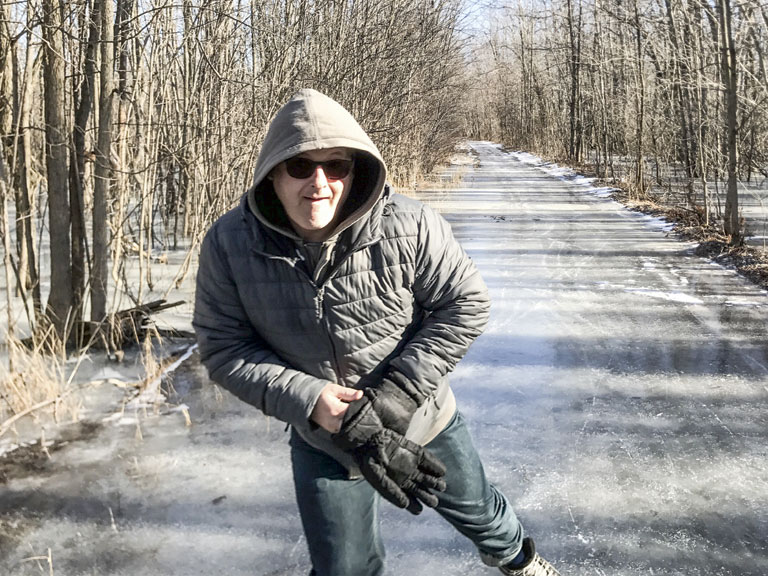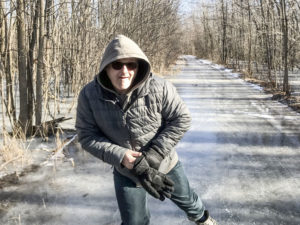County News
Adaptable water managers

Just weeks after drought emergency declared, beavers were splashing around Hubbs Creek Marsh
Near the end of August, my 19-yearold daughter and I spent six and half days travelling back and forth from the Picton hospital every eight hours so she could get intravenous antibiotics to fight an anaerobic infection that had rapidly developed following an operation to have her wisdom teeth removed. At some point during the haze of those scary days, my daughter groggily looked out the kitchen window and said, “Mom, it doesn’t look real.” I suddenly saw what she saw. After the worst drought in living history, it had started to rain. Our lawn, which had turned brown by the end of May, bonewhite and dusty by mid-July, was green.

John Sanders skates along the Millennium Trail earlier this month on ice as smooth as glass. Beavers have returned to the Hubbs Creek Marsh, signalling the end of a serious drought.
Three weeks later, in mid-September, I saw another amazing sight. Walking along the Millennium Trail at the Hubbs Creek Marsh, I noticed two streams of deep water on either side of the Trail that abruptly ended at two piles of muddy sticks. The beavers were back.
They had abandoned their dams when the drought had deprived them of water to store. Eventually the dams broke apart, leaving behind a tangle of sticks and branches strewn across the now crispy landscape. In six years observing these animals, the dam had remained intact.
But just weeks after Quinte Conservation and the County declared a drought emergency, the beavers were back and their dam had been reassembled. Most surprisingly, a large pool had formed behind it.
Households were still being asked to consume 50 per cent less water and pick-up trucks loaded with huge white water tanks were still a familiar occurrence along County roads.
Shortly after Christmas, I checked out my other favourite wetland along the Millennium Trail: Slab Creek. The beavers had finally returned there too. So, the weekend before last—before the long mid-winter thaw—my husband and I donned our skates at Slab Creek and navigated through the trees along the Trail for more than half a kilometer. Pristine clear ice; thanks to the beavers.
February 2 is World Wetlands Day, a day observed to commemorate the Ramsar Convention, the oldest of the modern global intergovernmental environmental agreements. The treaty “provides the framework for national action and international cooperation for the conservation and wise use of wetlands and their resources.” So far, 169 countries have signed on. Canada joined in 1981.
In 1981 as well, Ontario started developing policy to identify and protect wetlands. By 1988, it had developed the Ontario Wetland Evaluation System (OWES), the process through which it identifies Provincially and Regionally Significant wetlands. Through this MNRF framework, the province ranks wetlands relative to one another through a point system. Points are given for the biological and hydrological importance of the wetland— for its size and the biodiversity of species it supports, and for its societal value—for instance, the important role it plays in supporting recreational activities like hunting and fishing. The Hubbs Creek Wetland system is rated as Provincially Significant (PSW) and the Slab Creek Swamp is Regionally significant (RSW). Prince Edward County itself is home to 26 PSWs and 15 RSWs. We are a wetland haven.
This year, the theme for World Wetlands Day focuses on the role wetlands play in mitigating natural disasters. They are landscapes that act like sponges, absorbing and releasing water over time. According to the government of Ontario, they are among the most productive and biologically diverse habitats on Earth, providing priceless services like wildlife habitat, fish habitat, water quality improvement, flood control, ground water recharge and discharge, erosion reduction, food sources, recreation and tourism opportunities and climate change mitigation (wetlands are great at sequestering carbon). The keystone species of our wetlands, the species that helps enable our wetlands to do all that they do, is Castor Canadensis, the beaver. Their damming practices not only help expand wetlands and fill them with nutrients, but also capture water, enabling it to go back into our water table where it will replenish our diminished wells and aquifers. That’s why it was so amazing to see those dams up and running again even though the rains had barely begun.
On February 2, many may be scouting about looking for a groundhog and determining whether or not it sees its shadow. But I’ll be looking for signs of another mighty rodent. Perhaps I’ll go check out the new wetland berm Ducks Unlimited has built near Closson Road where the Slab Creek and Hubbs Creek wetlands converge and see how much it has filled up. And then, if I am lucky and the conditions are right, I’ll grab my skates and go back to Slab Creek.

Great piece!! Would love to see similar articles on wetlands and wildlife in the County. Thank you.